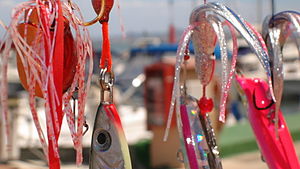This article includes a list of references, related reading, or external links, but its sources remain unclear because it lacks inline citations. (April 2009) |


Jigging is the practice of fishing with a jig, a type of weighted fishing lure. A jig consists of a heavy metal (typically lead) sinker with an attached fish hook that is usually obscured inside a soft lure or feather-like decorations. Jigs are intended to create a jerky, vertical "jumping" motion to attract fish, as opposed to other common lures like swimbaits, spoons and spinnerbaits, which move through the water more or less horizontally. The jig is very versatile and can be used in both salt and fresh water. Many deeper water fish species are attracted to the lure, which has made it popular among anglers for years.
The jigging technique mainly involves rapid lifting motions of a fishing rod, which jerk the line exert a temporarily upward pull upon the sinking lure. When the target fish is enticed to swallow the lure, the angler then sets the hook to pierce and tether the fish in the mouth. Because the jigs are weighted, a harder-than-usual hookset is often needed to overcome the added weight and provide sufficient momentum to pierce the hook point into the fish mouth. Jigging gears are often involved with the luring of slow moving fish, most commonly during spawning periods. For successful jigging, the jigger needs to use a sensitive rod that is good for feeling a strike, and needs to stay in contact with the lure and get it to where the fish are. Most fish caught by jigs are on or near the bottom.